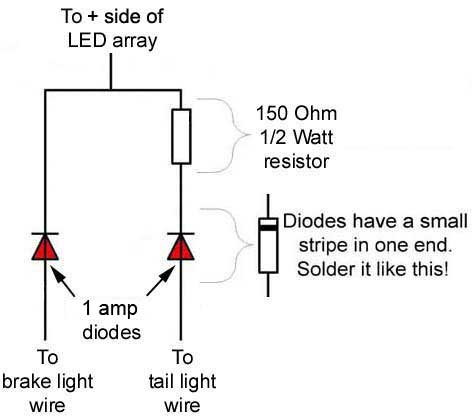I took my LIN3 to the next level, added a running light function to it. So (for the last 3 yrs I guess) it's been dual purpose! Lower output for running, full high for brake.
Parts needed (Radio Shack; if you don't have these already, and a couple of bucks total at best and I have left overs somewhere that I would be glad to give away to someone, just have NO friggen idea where they got put!).
(2) 5A Diodes, (1) 12v, 1w 500-600 ohm Resistor
(12v Running Light Feed)---------[5A Diode
| ]----------[1w 12v 500-600ohm Resistor]----}------/to LED light (combined w below wire)
(12v Brake Light Feed)------------[5A Diode
| ]-----------------------------------------------------}------/to LED light (combined w above wire)
Just note on wiring in the Diode, there is a striped side (denoted as
| above), this is the anode and needs to be at the tail-end of the power flow. It works as a back door, basically power can't flow upwards of this and back into the other feed (circuit).
<edit> argh! after typing all that out, I figured there has to be a graphical image on this cuz... there's everything on the net, right?
I used a different resistor is all, this will effect the running lights brightness. Play with it to your liking maybe? And yes, you can go and buy this premade for outrageous bucks. Since most of my friends here are frugal, this is your method and it works perfectly!
Enjoy!























































